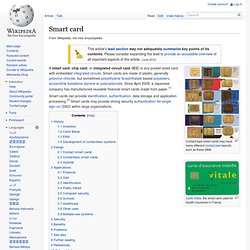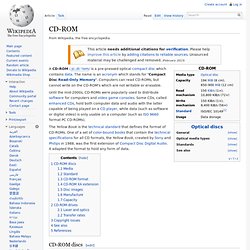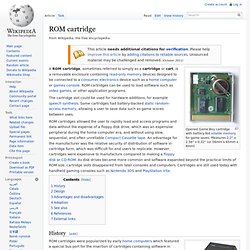

Cloud computing. Cloud computing metaphor: For a user, the network elements representing the provider-rendered services are invisible, as if obscured by a cloud.

Cloud computing is a computing term or metaphor that evolved in the late 1990s, based on utility and consumption of computer resources. Cloud computing involves application systems which are executed within the cloud and operated through internet enabled devices. Purely cloud computing does not rely on the use of cloud storage as it will be removed upon users download action. Clouds can be classified as public, private and hybrid.[1][2] Overview[edit] Cloud computing[3] relies on sharing of resources to achieve coherence and economies of scale, similar to a utility (like the electricity grid) over a network.[2] At the foundation of cloud computing is the broader concept of converged infrastructure and shared services. Cloud computing, or in simpler shorthand just "the cloud", also focuses on maximizing the effectiveness of the shared resources.
Blu-ray Disc. Blu-ray Disc (BD) is a digital optical disc data storage format designed to supersede the DVD format, in that it is capable of storing high-definition video resolution (1080p).

The plastic disc is 120 mm in diameter and 1.2 mm thick, the same size as DVDs and CDs.[4] Conventional (pre-BD-XL) Blu-ray Discs contain 25 GB per layer, with dual layer discs (50 GB) being the industry standard for feature-length video discs. Triple layer discs (100 GB) and quadruple layers (128 GB) are available for BD-XL re-writer drives.[5] The name Blu-ray Disc refers to the blue laser used to read the disc, which allows information to be stored at a greater density than is possible with the longer-wavelength red laser used for DVDs. The major application of Blu-ray Discs is as a medium for video material such as feature films and physical distribution of video games for the PlayStation 3, PlayStation 4 and Xbox One.
Smart card. Contact-type smart cards may have many different contact pad layouts, such as these SIMs Carte Vitale, the smart card used for health insurance in France A smart card, chip card, or integrated circuit card (ICC) is any pocket-sized card with embedded integrated circuits.

Smart cards are made of plastic, generally polyvinyl chloride, but sometimes polyethylene terephthalate based polyesters, acrylonitrile butadiene styrene or polycarbonate. Since April 2009, a Japanese company has manufactured reusable financial smart cards made from paper.[1] Smart cards can provide identification, authentication, data storage and application processing.[2] Smart cards may provide strong security authentication for single sign-on (SSO) within large organizations. History[edit] Invention[edit] In 1968 and 1969 German electrical engineers Helmut Gröttrup and Jürgen Dethloff jointly filed patents for the automated chip card (for details see page of Helmut Gröttrup). DVD. DVD (sometimes explained as "digital video disc" or "digital versatile disc"[5][6]) is a digital optical disc storage format, invented and developed by Philips, Sony, Toshiba, and Panasonic in 1995.

DVDs can be played in many types of players, including DVD players. DVDs offer higher storage capacity than compact discs while having the same dimensions. Pre-recorded DVDs are mass-produced using molding machines that physically stamp data onto the DVD. CD-ROM. A CD-ROM /ˌsiːˌdiːˈrɒm/ is a pre-pressed optical compact disc which contains data.

The name is an acronym which stands for "Compact Disc Read-Only Memory". Computers can read CD-ROMs, but cannot write on the CD-ROM's which are not writable or erasable. The Yellow Book is the technical standard that defines the format of CD-ROMs. One of a set of color-bound books that contain the technical specifications for all CD formats, the Yellow Book, created by Sony and Philips in 1988, was the first extension of Compact Disc Digital Audio. It adapted the format to hold any form of data. ROM cartridge. Opened Game Boy cartridge with battery-fed volatile memory for game saves.

Measures 2.2" x 2.56" x 0.32" (or 56mm x 65mm x 8mm) A ROM cartridge, sometimes referred to simply as a cartridge or cart, is a removable enclosure containing read-only memory devices designed to be connected to a consumer electronics device such as a home computer or games console. ROM cartridges can be used to load software such as video games, or other application programs. The cartridge slot could be used for hardware additions, for example speech synthesis. Game controller. A North American Super NES game controller from the early 1990s.

A game controller is a device used with games or entertainment systems to provide input to a video game, typically to control an object or character in the game. A controller is usually connected to a game console or computer by means of a wire or cord, although, since the mid-2000s, wireless controllers have become widespread. Input devices that have been classified as game controllers include keyboards, mice, gamepads, joysticks, etc. Special purpose devices, such as steering wheels for driving games and light guns for shooting games, are also game controllers.
One of the first video game controllers was a simple dial and single button, used to control the game Tennis for Two. Variants[edit] Gamepad Paddle Joystick A joystick is a peripheral that consists of a handheld stick that can be tilted around either of two axes and (sometimes) twisted around a third. Trackball Throttle quadrant Steering wheel Yoke Pedals Keyboard and mouse.